JUNE NEWSLETTER: Edit your quarterly commentary using this process!
Do you want your quarterly commentary to shine? Polish it using the process that I describe in “5 steps for rewriting your investment commentary.” This is how I edit my clients’ work.
The main idea is to start editing at the big picture level and then work down to more specific elements of your commentary. This saves you from spending a lot of time on information that ultimately gets cut from your piece.
You can learn a lot more about the specifics of my writing process in Financial Blogging: How to Write Powerful Posts That Attract Clients.
Get Google’s help removing your personal data from the internet
Google’s “Results about you” tool can help you remove some of your personal information from the internet. I tried it and got some information removed.
Learn more from “Why You Should Google Your Own Name Today” by Zak Doffman on Forbes.
Keyboarding on the go
 People always comment when I use this compact multi-device wireless keyboard from Logitech to take notes on my phone at conferences. I love its cradle to hold my phone upright so I can follow along as I type.
People always comment when I use this compact multi-device wireless keyboard from Logitech to take notes on my phone at conferences. I love its cradle to hold my phone upright so I can follow along as I type.
You can use this keyboard with three different devices. Simply turn the dial to select the device that you’ve connected earlier via Bluetooth.
I use this keyboard almost daily with my personal computer because I like its narrow width. The batteries last a very long time.
Pumpkin pie smoothie
I like smoothies. My standard is a smoothie made with banana, peanut butter powder, and milk.
However, sometimes I go a little wild. Like when I made the KaleJunkie.com’s tasty smoothie recipe described in “My Favorite Pumpkin Pie Smoothie.” I also enjoyed her “Pumpkin Pie Overnight Oats.”
Hellebores
 I love hellebores, one of the first plants to flower in the spring. But I’m frustrated by how their heads hang down, concealing their beauty. That’s why I sometimes cut off some flowers and float them in a bowl, as you see in my photo.
I love hellebores, one of the first plants to flower in the spring. But I’m frustrated by how their heads hang down, concealing their beauty. That’s why I sometimes cut off some flowers and float them in a bowl, as you see in my photo.
What my clients say about me
 “Fast, effective, insightful. I can think of no better resource for superior financial writing.”
“Fast, effective, insightful. I can think of no better resource for superior financial writing.”
“Susan has an exceptional ability to tailor investment communications to the sophistication level of any audience. She has an uncanny ability to make very complex investment and/or economic topics accessible and understandable to anyone.”
“Susan’s particularly good at working through highly technical material very quickly. That’s very important in this business. A lot of people are good writers, but they have an extensive learning curve for something they’re unfamiliar with. Susan was able to jump very quickly into technical material.”
Improve your investment commentary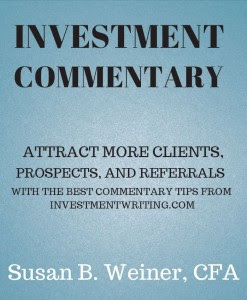
Attract more clients, prospects, and referral sources by improving your investment commentary with 44 pages of the best tips from the InvestmentWriting.com blog.
Tips include how to organize your thoughts, edit for the “big picture,” edit line by line, and get more mileage out of your commentary.
Available in PDF format for only $9.99. Email me to buy it now!
Boost your blogging now!
Financial Blogging: How to Write Powerful Posts That Attract Clients is available for purchase as a PDF ($39) or a paperback ($49, affiliate link).
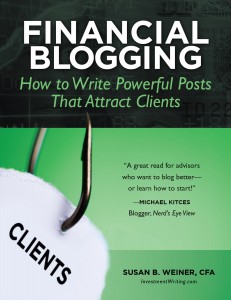


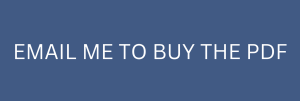

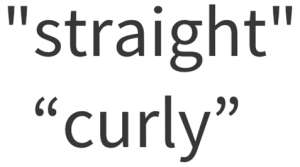



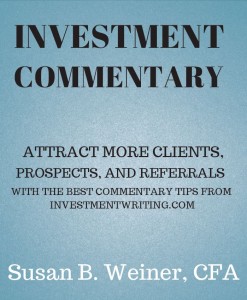 Keep my practical writing tips handy with my two PDF e-books.
Keep my practical writing tips handy with my two PDF e-books.
 Hire Susan to speak
Hire Susan to speak


